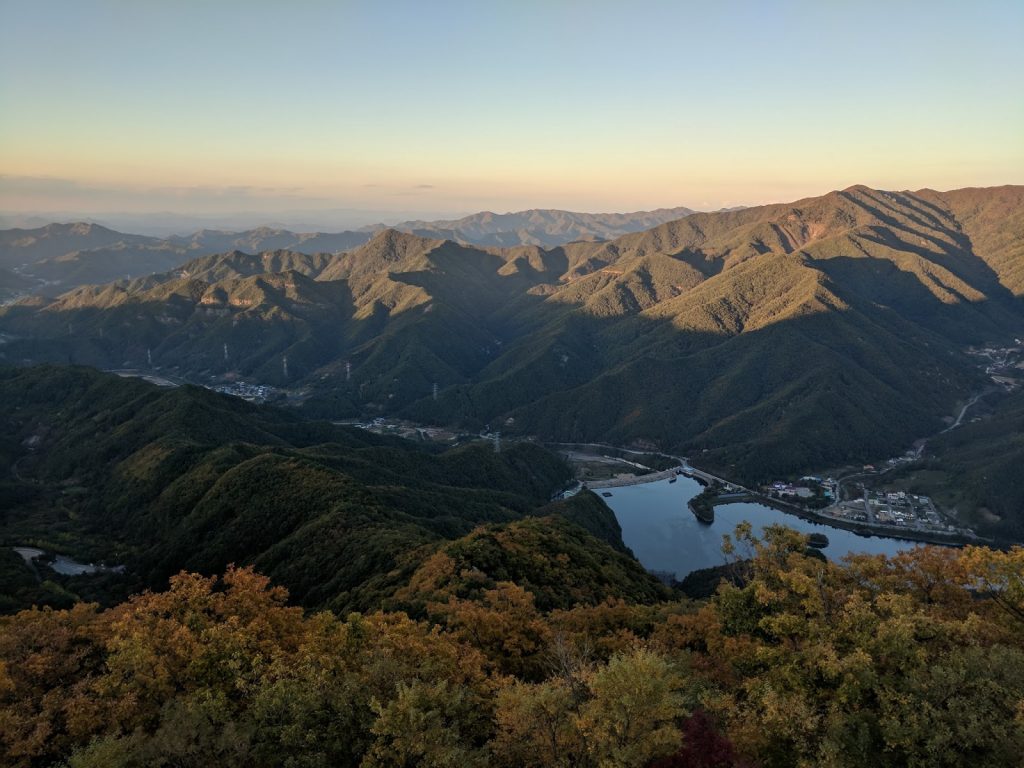In the last post, I mentioned the problem of deforestation in Malaysia and Indonesia. To counter that depressing information, I thought I should share a success story: the reforestation of South Korea.
Koreans historically have had a strong cultural and religious connection to their forests and trees. The pine tree, in particular, represented steadfastness, strength, and longevity. Koreans used to hang pine tree branches over the entrance to their homes when a baby was born, to ensure the baby would grow as strong as the pine and live as long. The trees also provided a strong foundation for a hanok, a traditional Korean home.* The Geumgang pine tree was especially prized for its high wood density, and during the Joseon era was only allowed to be used in royal palaces.

Very large and very old trees were believed by many Koreans to hold a character and personality all their own. I read a story about a village in our province with a 500+ year old tree that protects the village. According to villagers, young people prayed to the tree before leaving to fight during the Korean War; all those who prayed returned home unharmed. (The tree is one of many designated a national monument.)
Unfortunately, Korean forests were largely damaged or destroyed during the first half of the 20th century.
Today is Samil Day, a holiday commemorating Korean protests against the Japanese occupation. (I wrote a bit about it here.) The Japanese colonizers used Korea extensively for resources. Not only did they hunt all the tigers and seals to extinction, but they chopped down large swaths of forests – in addition to driving metal spikes into the mountains to “kill the mountain spirits” and demoralize Koreans. The Japanese were jerks. There’s a reason Koreans were outraged over Joshua Cooper Ramo’s comment at Pyeongchang.

Forests were further degraded during the Korean War and by Korean citizens who needed fuel for cooking and heating during their time of extreme poverty. By 1955, forest cover in Korea had dropped to 35% of land area. For reference, around 70% of Korean land is mountain and 22% is used for agriculture. In some regions, the denuded mountains had such badly eroded soil that they looked like sand dunes. Landslides and flooding became big problems.

To tackle these problems, the Korean government started the Korea Forest Service** (KFS) in 1967 and created a number of policies to protect the forests, such as criminalizing illegal logging. In 1973, the government began the Forest Rehabilitation Project. The project had five phases, each scheduled for 10 years, though some phases were completed early.
The planning and effort that went into the reforestation project was incredible. I won’t describe the entire process here, but this video shows how much work it took to restore the most severely denuded and eroded mountains.

The reforestation effort was helped along by many factors: the economy of South Korea was improving; people began moving to urban areas; the country began to use coal for energy rather than firewood; President Park Chung-hee made tree planting a patriotic issue (“If you love your country, plant trees!”); Korean community-oriented culture; and Koreans’ view of mountain forests as sacred places.
South Koreans have planted around 11 billion trees since 1973. Though the national government directed efforts, much of the work was done at a local level. Villagers were encouraged to grow saplings to sell for the reforestation efforts, and communities would organize tree-planting events.
Because of the reforestation project, today 64% of Korea’s land is covered in forests. It brings an estimated $103 billion dollars (US) a year in “ecosystem services and products,” according to the KFS. Another analysis I read described these economic benefits as water benefits, carbon sequestration and air quality improvements, erosion control, forest-based recreation, and other benefits. (I’ll talk more about the “forest-based recreation” in a later post.)
The KFS has continued to develop a sustainable forest management system that it can share with other countries facing deforestation (like Indonesia). In fact, I’ve read in several places about different reforestation projects Korea is involved with overseas. I tried to find a summary of those projects, but there are just a ton of them, apparently. South Korea is working with the UN’s Convention to Combat Desertification and with the Intergovernmental Platform on Biodiversity and Ecosystem Services. The Korean government started the Asian Forest Cooperation Organization (with ASEAN) and the KFS began the Forest Ecosystem Restoration Initiative. They also have bilateral partnerships with over 30 countries to help combat deforestation and desertification, and apparently have scientists working to preserve and/or improve the DNA of native tree species.
Today, when we drive around Korea, I’m always struck by the beautiful mountains and forests (coming from the desert, as I do). They are especially beautiful in the rainy season, when mist sits in the crooks and valleys. I sincerely hope that more countries follow Korea’s example of sustainable land management and forest restoration.***

*We stayed in a hanok in January. I will post more about that soon.
**The KFS tagline on their website is “Come nestle in the bosom of our green forest.” I love it.
***China has made some impressive gains in their reforestation efforts, and they’ve spent the billions to prove it. In recent years, they’ve reforested areas that are the combined size of New York and Pennsylvania, and have plans to replant an area the size of Ireland this year. While there are some questions about biodiversity and shifting deforestation to other countries by instead importing lumber to China, it is definitely a step in the right direction. Removing presidential term limits, on the other hand, is definitely a step in the wrong direction.

